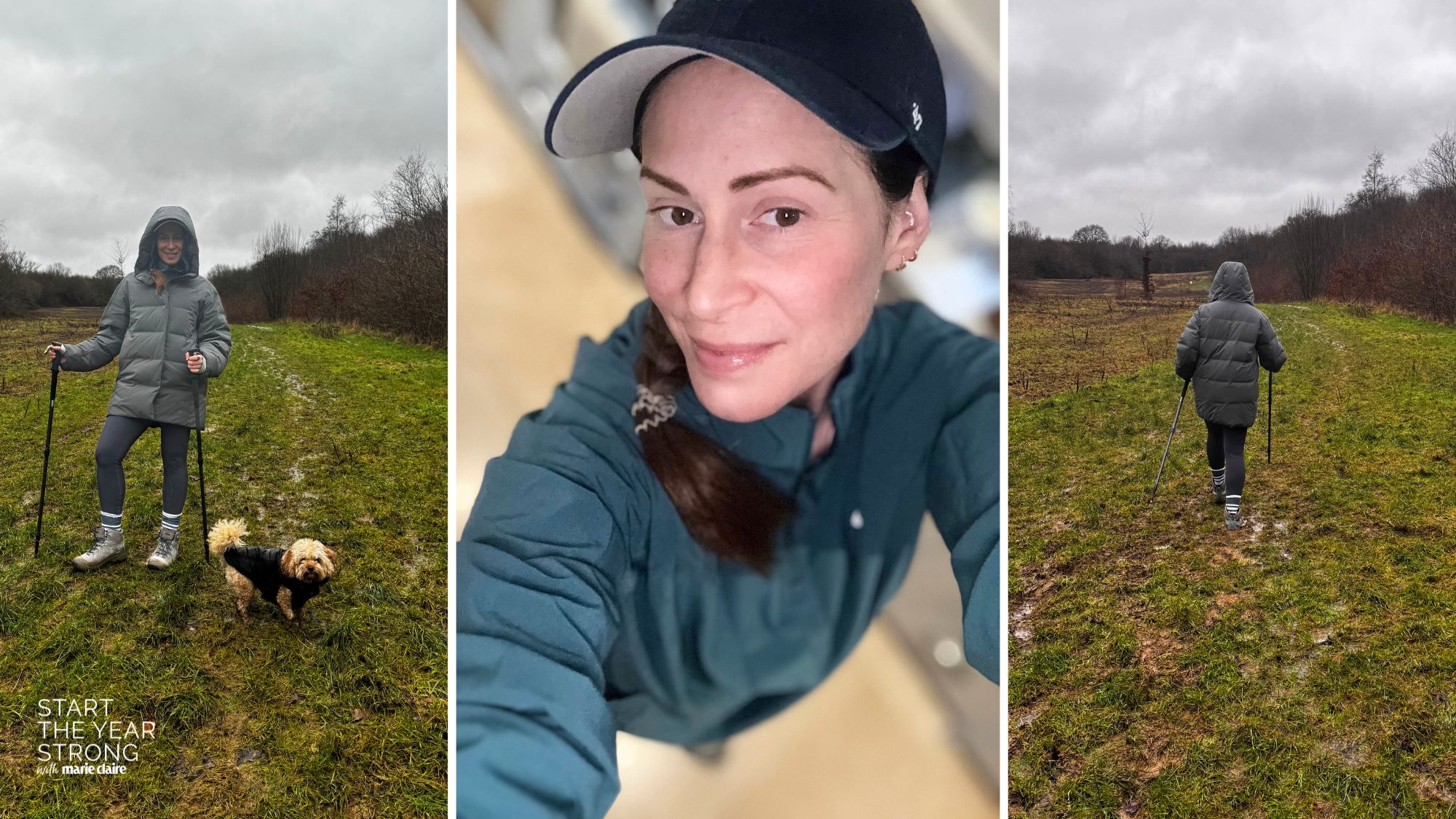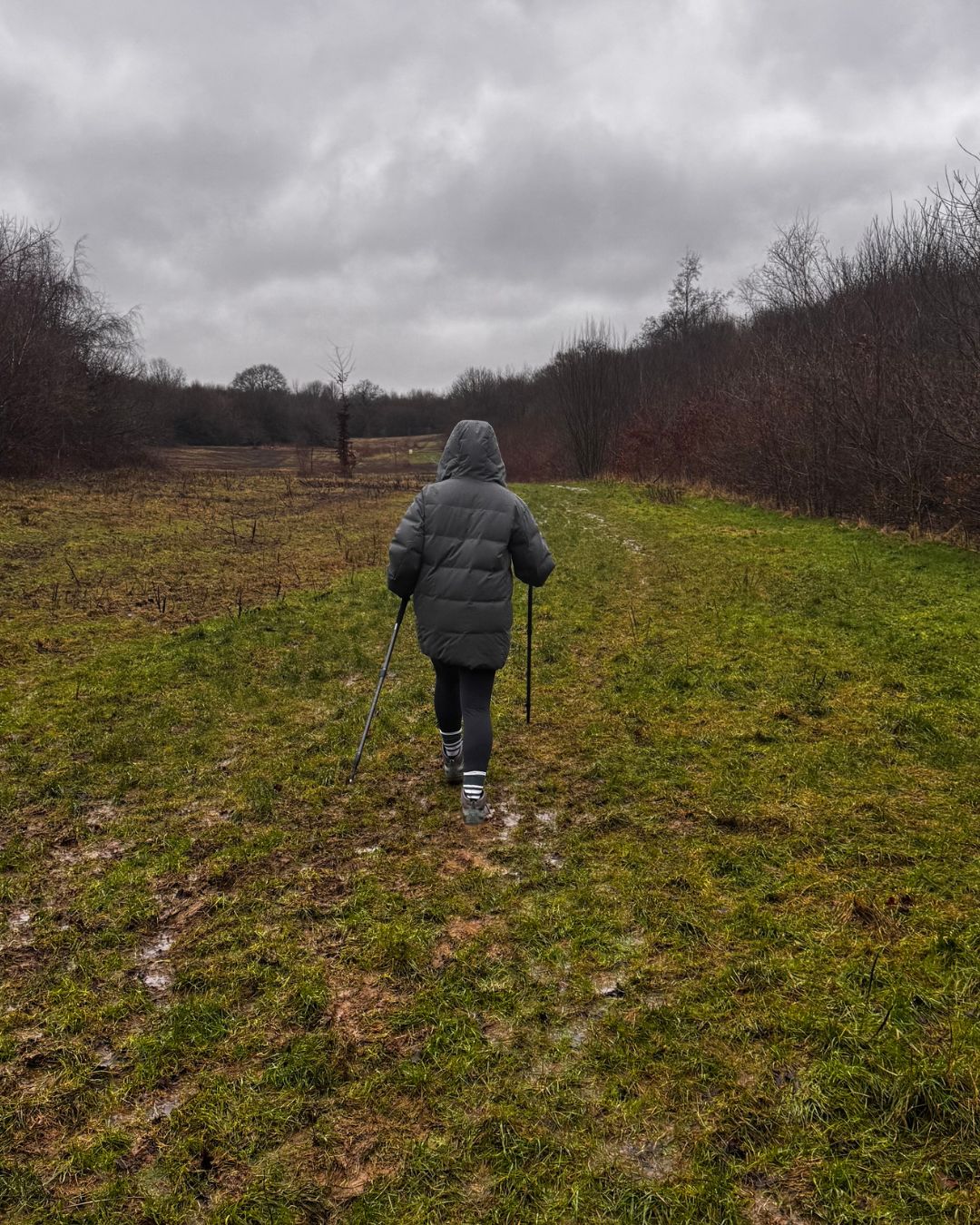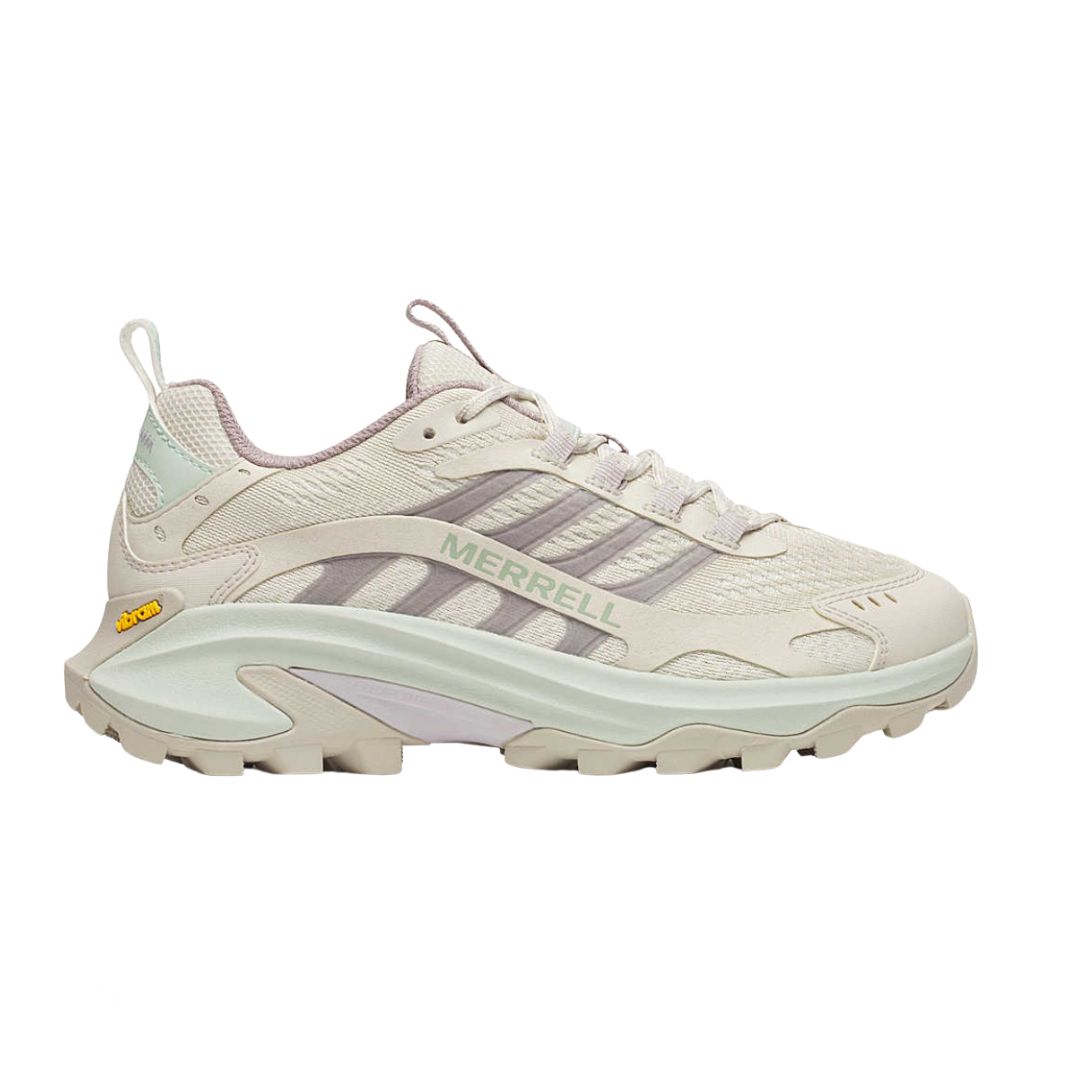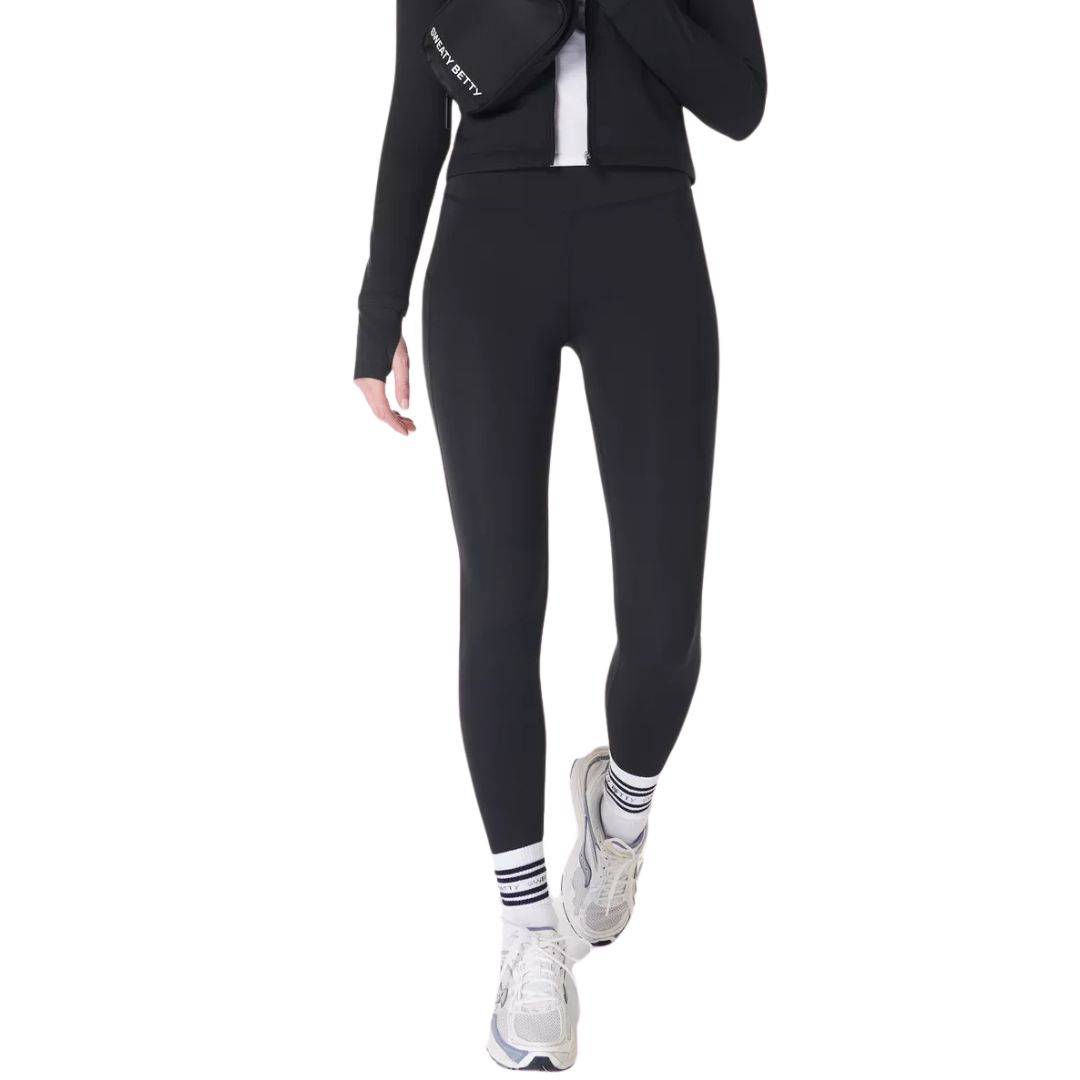I wanted to up the intensity of my walks, so tried Nordic walking every day for a week - and feel it's levelled up my cardio fitness
Who knew holding poles was such hard work?


I'm going to start by being totally honest with you: it's only been in the last year that I've considered walking a workout. Previously, I'd (mistakenly - and how wrong I was) chalked it up as not being "challenging" enough for me.
But after struggling with my energy levels, a recurring hip injury and teetering on the brink of burnout a couple of years ago, I swapped my high-intensity regime for an altogether more holistic approach to fitness. Incorporating plenty of low-impact strength, Pilates and low-intensity cardio has suited me down to the ground - and walking has been a huge part of that.
It's no coincidence that walking is so popular right now. Interest in the humble stroll has peaked in the last few years as many of us seek more sustainable and achievable fitness goals, not to mention the fact that there's some scientific backing on the benefits of walking. Studies (such as this one, published in the British Journal of Sports Medicine) show that there's a direct correlation between how many steps we walk per day and all-cause mortality - and that's before we take into account how great it is for our mental health, too.
So, when I read that Nordic walking is purported to supercharge all the usual benefits you'd associate with going for a stroll (studies like this paper show that it's great for strength, endurance and mental health), I was keen to give it a try. Could adding a couple of poles to my daily walk really ramp up the intensity - especially in someone who (IMHO) is already relatively fit and healthy?
"There is substantial research supporting the benefits of Nordic walking," explains Bente Smith-Rewse, biomechanics specialist and founder of Enertor. "In terms of cardiovascular health, Nordic walking has been found to significantly improve VO2 max, which is a key indicator of aerobic fitness, outperforming regular walking in this regard. Furthermore, research highlights its mental health benefits, with a 2021 study revealing that Nordic walking reduces symptoms of depression and anxiety due to its rhythmic, meditative qualities and connection to nature."
It was time to find out for myself - keep scrolling to find out how I got on. Walking your jam? Don't miss our guides to indoor walking workouts, indoor walking challenges or indoor walking workouts for beginners, here. There are loads of benefits to a walking desk, too, as Senior Health Editor Ally Head found out during her walking desk review. Prefer fresh air? Walking workouts at the ready. Or, if you're keen to see how MC UK staffers fared trying other steps-based challenges, read how we got on trying walking every day for two weeks, the 6-6-6 walking challenge, and walking 8k steps a day, here.
New research just found Nordic walking to be seriously effective - so I tried it
What is Nordic walking?
Put simply, Nordic walking is regular walking, with the addition of a long pole in each hand for stability. Originally, walking with ski poles became popular as a summer activity for skiers in Scandinavia in the late 1960s as a way of maintaining fitness in the off-piste season. And to say it took off is an understatement: it's all over TikTok, right now.
Celebrity news, beauty, fashion advice, and fascinating features, delivered straight to your inbox!
"Nordic walking is an amazing full-body exercise that combines walking with the use of specially designed poles to engage the upper body," explains Smith-Rewse. "Originally developed as a summer training method for cross-country skiers, it has evolved into a popular activity for people of all fitness levels. The technique involves planting the poles in coordination with your stride, which propels you forward while activating muscles in the arms, shoulders, core, and legs. This coordinated movement creates a dynamic, efficient workout that is accessible and beneficial for a wide range of individuals."
What are the benefits of Nordic walking?
If you're wondering why bother, you might be interested to learn that the benefits of Nordic walking far outweigh your average stroll.
"The benefits of Nordic walking are extensive, making it a highly effective form of exercise," notes Smith-Rewse. "By engaging the upper body and core, it burns significantly more calories than regular walking—up to 46% more—making it ideal for weight management and fitness. It also promotes better posture by encouraging spinal alignment and reducing slouching.
"Additionally, the use of poles redistributes body weight, which alleviates strain on the knees and hips, making it particularly suitable for individuals with joint issues. Crucially, Nordic walking boosts cardiovascular fitness, improving heart health and endurance. Its unique ability to engage 90% of the body’s muscles results in a comprehensive, low-impact workout that strengthens and tones the entire body." I'm in - where do I sign up?
How to do Nordic walking
The good news continues: Nordic walking is super simple to get the hang of, although if you're recovering from an injury it's best to check your form is good before committing to an hour's hike.
"To ensure a safe and enjoyable Nordic walking experience, it’s important to focus on proper technique, foot health and footwear," agrees Bente-Rewse. "Start by learning the correct method, either through classes or instructional videos, to avoid strain or injury."
I tried Nordic walking every day for two weeks - here are my thoughts
Days one to three
Once my poles arrived (I used these ones, from Decathlon), I was keen to get going. As always, I started off by talking to the experts to make sure I was ready to get the most out of my challenge - being relatively fit and healthy, I'm confident I can set out with good form.
I've done many things in the name of workout research, but I'll level with you - I wasn't ready to hit my local high street armed with my poles. Luckily, I've got some amazing countryside on my doorstep so a post-prandial Sunday stroll seemed the perfect introduction to Nordic walking.
And the experts were right, on a few points: it was incredibly simple to get the hang of (once I'd worked out how to get the poles to the correct height for me) and it was so much tougher than I'd anticipated. Not helped by the terrain being water-logged and muddy - it was a challenge to keep my balance at times, and I was grateful for the poles!
Turns out, it's super important to lock the poles into position before setting out - trust me, you don't want to be squelching your way back through puddles to retrieve a lost pole end like I had to. Overall, though, I deemed day one a success.
Days two and three continued in the same vein – honestly, the hardest part (as is so often the case, when it comes to working out) was faffing around making sure I wasn’t going to get soaked – perhaps January wasn’t the best time for this trial! That said, it was a nice, relatively gentle way to up my steps and activity levels, which I always take as a win.

Anna during one of her Nordic walks, walking with poles
Days four to seven
Mid-week, annoyingly, I’m frustrated to find an old hip injury has recurred, which makes walking a lot more painful than it should be. However, since I’m signed off more strenuous forms of exercise for a while, I’m grateful to be able to pick up my sticks and head out of the door.
And I have to say, while the physical benefits of Nordic walking can’t be argued with, by far my biggest takeaway is the effect it’s had on my frame of mind. Even though I try to weave some movement into my every day, this is usually in the form of a home workout – meaning some weeks, I barely leave the house except for the school runs. But this week, I’m out in the fresh air each day – and I love it. I’ve always known that exercising in nature instils a deep sense of calm and connection with the outside world, but as a runner, I’m usually too focused on my pace and time to really notice.
Nordic walking has forced me to slow down and take a moment (not least to recover my poles!), which, for someone with chronically high-stress levels and more than a modicum of anxiety, is priceless. I’m so much calmer, I can’t believe walking isn’t prescribed on the NHS. Oh! Hang on... it is…

Anna at the end of one of her Nordic walks
Will I continue Nordic walking?
At the end of the week, I reluctantly hang up my poles and put away my walking boots (PSA: do make sure your footwear is fit for purpose. I wore these Keen boots and my feet remained dry and comfortable throughout, and the ankle support was excellent, too) but I make a promise to myself to continue. Just maybe not every day.
Shop MC UK's go-to walking kit now:
How does Nordic walking differ from regular walking?
"Nordic walking differs from regular walking in both style and benefits," explains Smith-Rewse. "Unlike traditional walking, it involves the active use of poles, which engages the upper body, including the arms, shoulders, and back. This full-body movement not only enhances calorie burn but also improves stride efficiency and stability. The poles help lengthen your stride and propel you forward more effectively."
Not just that, but "Nordic walking is also kinder to the joints, as the poles absorb and redistribute impact forces, reducing strain on the knees and hips," they go on. "It's also safer over more challenging terrain, you have the added benefit of the poles that increase stability reducing falls. In essence, it provides a more intensive workout while being gentler on the body compared to regular walking."

Anna Bartter is a freelance journalist who writes about health, fitness and women's lifestyle for publications including Stylist, Metro and Psychologies, among others.
She's always on a quest to find a variety of fun and functional workouts that give you the most bang for your workout buck and she's passionate about championing movement for everyone's mental and physical wellbeing.



